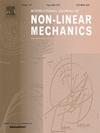Efficient structural optimization under transient impact loads using multilayer perceptron and genetic algorithms
IF 3.2
3区 工程技术
Q2 MECHANICS
International Journal of Non-Linear Mechanics
Pub Date : 2024-11-05
DOI:10.1016/j.ijnonlinmec.2024.104950
引用次数: 0
Abstract
Currently, there is a lack of structural optimization methods when a structure is suffering transient impact load, considering nonlinear factors such as material plasticity and strain rate effect. The utilization of derivative-free algorithms also increases computational expenses. Accordingly, this paper presents a novel structure transient optimization approach based on multilayer perceptron combined with a derivative-free optimization method, which can efficiently solve the transient structure dynamics optimization problem with multiple optimization objects. In this approach, the area to be optimized is cut by several closed B-spline curves whose shapes are controlled by several parameters and can be varied and merged at each optimization iteration step. The structure's transient analysis process is replaced by a machine learning based surrogate model, which is trained by thousands of results from the FEM explicit transient simulation. Additionally, nearly orthogonal Latin hypercube sampling is utilized to simplify parameter dimensionality, reduce the training data set, save calculation time, and give the training data set a more comprehensive range of design parameters. In our optimization process, our design target is to minimize the peak reaction force while with the constrain of ensuring enough stiffness and mass. The results demonstrate our proposed methods could efficiently handle transient optimization problems without sensitivity calculations, exhibiting strong generalization capabilities.
利用多层感知器和遗传算法对瞬态冲击载荷下的结构进行高效优化
目前,当结构承受瞬态冲击载荷时,考虑到材料塑性和应变率效应等非线性因素,还缺乏结构优化方法。无导数算法的使用也增加了计算费用。因此,本文提出了一种基于多层感知器的新型结构瞬态优化方法,结合无导数优化方法,可以高效解决具有多个优化对象的瞬态结构动力学优化问题。在该方法中,待优化区域由多条封闭的 B-样条曲线切割而成,这些曲线的形状由多个参数控制,并可在每个优化迭代步骤中进行变化和合并。结构的瞬态分析过程由基于机器学习的代用模型取代,该代用模型是由成千上万的有限元显式瞬态模拟结果训练而成的。此外,还利用近乎正交的拉丁超立方采样来简化参数维度、减少训练数据集、节省计算时间,并使训练数据集具有更全面的设计参数范围。在优化过程中,我们的设计目标是在保证足够刚度和质量的前提下,使峰值反作用力最小。结果表明,我们提出的方法无需灵敏度计算即可高效处理瞬态优化问题,具有很强的泛化能力。
本文章由计算机程序翻译,如有差异,请以英文原文为准。
求助全文
约1分钟内获得全文
求助全文
来源期刊
CiteScore
5.50
自引率
9.40%
发文量
192
审稿时长
67 days
期刊介绍:
The International Journal of Non-Linear Mechanics provides a specific medium for dissemination of high-quality research results in the various areas of theoretical, applied, and experimental mechanics of solids, fluids, structures, and systems where the phenomena are inherently non-linear.
The journal brings together original results in non-linear problems in elasticity, plasticity, dynamics, vibrations, wave-propagation, rheology, fluid-structure interaction systems, stability, biomechanics, micro- and nano-structures, materials, metamaterials, and in other diverse areas.
Papers may be analytical, computational or experimental in nature. Treatments of non-linear differential equations wherein solutions and properties of solutions are emphasized but physical aspects are not adequately relevant, will not be considered for possible publication. Both deterministic and stochastic approaches are fostered. Contributions pertaining to both established and emerging fields are encouraged.

 求助内容:
求助内容: 应助结果提醒方式:
应助结果提醒方式:


